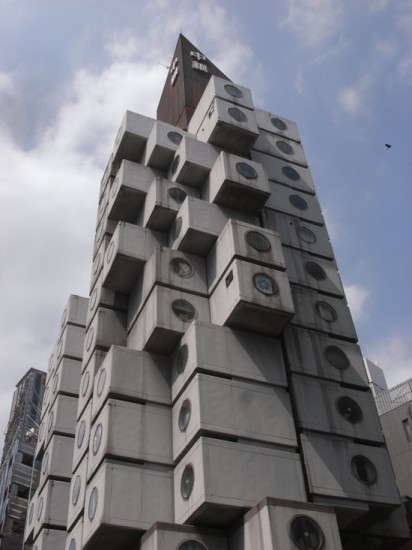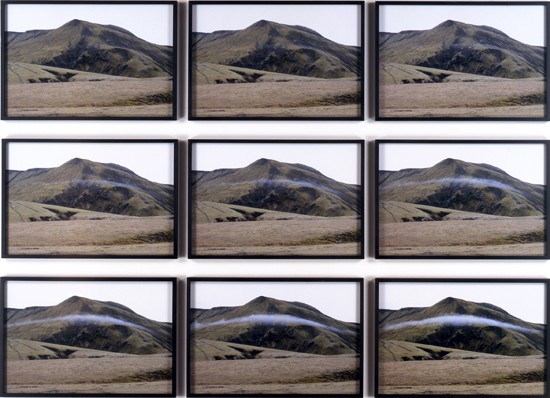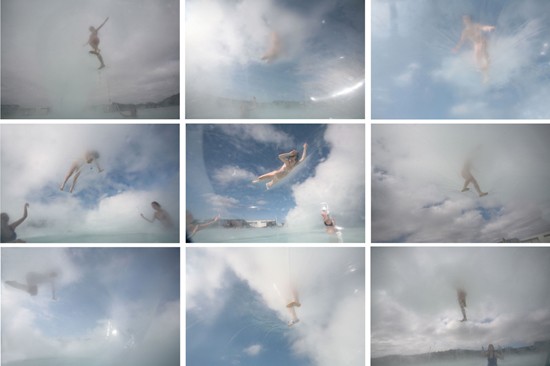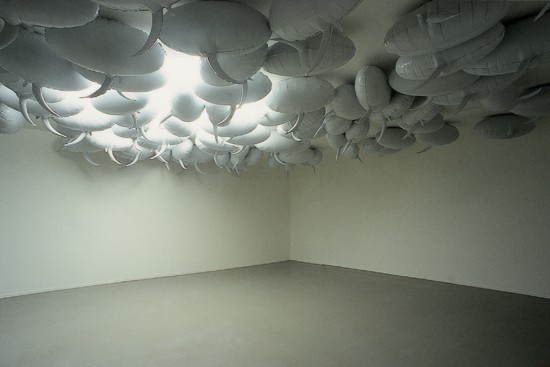THE PRODUCTION OF CLOUD
A letter from Hans Ulrich Obrist to Hou Hanru
 Koo Jeong-A – Petit déj’ & quick notes (2007), felt pen on paper, 45 x 64 cm. Courtesy the artist and Yvon Lambert Paris, New York.
Koo Jeong-A – Petit déj’ & quick notes (2007), felt pen on paper, 45 x 64 cm. Courtesy the artist and Yvon Lambert Paris, New York.Dear Hanru,
Many thanks for your message and the many interesting thoughts.
When you talk about the complexity of the Asian miracle, I think that one of the key points now is how we can actually use the current attention and hype to produce more memory, to go into more depth. The question is, how can we contribute to what Eric Hobsbawm calls an urgent protest against forgetting in the 21st century?
As visionary art historian Erwin Panofsky said, when we invent the future we often invent it out of fragments from the past. A pioneering movement in Asia is Metabolism. When you and I did “Cities on the Move,” Rem Koolhaas suggested that we look at the Metabolists as a toolbox to understand the urban mutations of our time. Several years later, in 2003, Rem and I decided to work systematically on an oral history and a big publication related to Metabolism, which will be published soon with the title Project Japan.
Metabolism is one of the most fascinating developments in postwar architecture, since it explores all the aspects of adaptability, change and renewal that I see as being especially important in the art context. To some degree, the moment of Metabolist architecture in Japan is inseparable from the tremendous forces of change and renewal that affected the country during the postwar period. This radical emergence required a distinctively Japanese Modernism, and this is the great achievement of the Metabolists.
 Nakagin Capsule Tower (1972) in Shimbashi, Tokyo.
Nakagin Capsule Tower (1972) in Shimbashi, Tokyo.With regard to Japan’s economic growth at the time, there was a deep optimism inherent in much of the architecture, an optimism appropriately framed by the decade of the 1960s, marked by the signing of Metabolism 1960: The Proposals for a New Urbanism and the important Expo ’70 in Osaka. This optimism is, for example, apparent in Kiyonori Kikutake’s Marine City proposal of 1958, which envisions an entirely new mode of life appropriate to the modern age. But it is also apparent in Kisho Kurokawa’s ever-controversial Nakagin Capsule Tower (1972) in Shimbashi, Tokyo, which is a powerful homage to the dynamism of the Japanese capital city and economic powerhouse: a residential building comprising two interconnected concrete towers, intended as distinctively Japanese but also somewhat Corbusian “machines for living” for the capital’s salarymen, featuring as standard all the amenities of modern life amid what Ernest Mandel once characterized as the “third industrial revolution” of mass consumption and rising living standards in the advanced economies. But it combines this with the quintessential Western image of contemporary Japanese living: the capsule, here able to be reconfigured and combined in different ways according to individual need. Kurokawa’s Capsule Tower is thereby simultaneously expressive of the widespread societal change then afoot, as well as the need for individual maneuverability within this larger systemic whole. Change and renewal, as the most important elements of what I understand by the “production of reality”, are directly indexed in Metabolist work. The enormous changes that Japan as a nation had to face in the immediate aftermath of the war were, I think, fundamental to the visions of renewal and change that we find in Metabolism
What is also detectable in Metabolist work is a strong emphasis, stemming from traditional Japanese architecture, on the notion that buildings and cities should be true to their environs. In traditional Japanese buildings there is the idea that architecture should be as natural as possible and should be in harmony with the rest of nature, since it is, after all, only temporarily there.

 Above: Olafur Eliasson – “The morning small cloud series” (2006), set of nine C-prints, 42 x 64 cm each; 136 x 196 cm group, edition of 6. Photo Jens Ziehe © 2006 Olafur Eliasson, courtesy the artist; neugerriemschneider, Berlin; Tanya Bonakdar Gallery, New York. Below: Tomas Saraceno – Untitled (2008), set of nine mounted C-prints, 26.5 x 40 cm each, edition of 5; 1 AP. Courtesy the artist and Tanya Bonakdar Gallery, New York.
Above: Olafur Eliasson – “The morning small cloud series” (2006), set of nine C-prints, 42 x 64 cm each; 136 x 196 cm group, edition of 6. Photo Jens Ziehe © 2006 Olafur Eliasson, courtesy the artist; neugerriemschneider, Berlin; Tanya Bonakdar Gallery, New York. Below: Tomas Saraceno – Untitled (2008), set of nine mounted C-prints, 26.5 x 40 cm each, edition of 5; 1 AP. Courtesy the artist and Tanya Bonakdar Gallery, New York.All of these ideas mean that Metabolism infused a particularly Japanese Modernism with some of the key ideas of postmodernism in architecture; especially, truth to surroundings, rather than the implantation of a transposable and monolithic International Style. But there was also a profound sense of experimentation and search for the new – rather than simply the recombination and resurrection of the old – that marks Metabolism out as very much part of the canon of architectural Modernism. Experimentation was inherent in the ways in which the Metabolists worked and collaborated. Metabolism was anything but the manifestation of a recursive, architectural argument; it was profoundly open to the world, not least in its engagement with questions of environment and ecology. It therefore has many potential lessons for us today, as we search for ways in which design might lead us into the future.
The challenges of sustainability, and therefore of urban wellbeing, demand that cultural production today reclaims its old sense of ambition and scale, that it once again embrace the possibilities of total design. Bruno Latour has recently called for an expanded role for design that extends “from the details of daily objects to cities, landscapes, nations, cultures, bodies, genes, and…to nature itself,” welcoming this as a novel “political ecology” that might “ease modernism out of its historical dead end.” This is not to say that we should resurrect anything like the monolithic aesthetic schemes of Modernism itself, but rather that we should borrow from their ambition in order to form our own dynamic, shifting and alterable institutions and spaces of the future.
One way of avoiding what is a potential pitfall of grand visions for the redesign and rebuilding of urban environments is to embrace possibilities for future change as an inherent facet of architectural and planning projects, in other words, to embrace impermanence and adaptability. It may not be too much of a stretch to imagine Metabolism as an object lesson in the way in which architecture might straddle these dual demands of the revisioning of the urban context and urban society, while at the same time accommodating uncertainty, becoming and the changeable.
 Philippe Parreno – Speech Bubbles (1997), mylar balloons, helium. Installation view at the Musée d’Art Moderne de la Ville de Paris, 2002. Collection Fonds Régional d’Art Contemporain Nord – Pas de Calais, Dunkerque. Courtesy Air de Paris, Paris.
Philippe Parreno – Speech Bubbles (1997), mylar balloons, helium. Installation view at the Musée d’Art Moderne de la Ville de Paris, 2002. Collection Fonds Régional d’Art Contemporain Nord – Pas de Calais, Dunkerque. Courtesy Air de Paris, Paris.Last but not least a few words on uncertainty. I was fascinated by the cloud of volcanic ash that obscured the sky earlier this spring, bringing European air space to a weeklong standstill. In the history of Western painting the cloud is a recurrent element that as the visionary French philosopher Hubert Damisch contends is the most fleeting of all masterpieces: clouds can be found everywhere from Giotto to Constable and onwards to Modernism. Damisch wrote in his 1972 book A Theory of /Cloud/ that the cloud is found exactly at the point in the system where it escapes. It vanishes within the graphic system only to discover itself again. Cloud archaeology is a science for angels. If the cloud is the zero degree of painting, geometry defaults where it meets the sky: The system of linear perspective cannot take into account the full complexity of visual experience and hence generates the cloud as a sign, as an agent, as a counter force with which it is in dialectical interaction. The cloud introduces something that has no place in painting but at the same time is painting. Damisch concludes that painting is itself defined within this paradox. Perhaps we have learned that air travel is defined within another paradox: the control of the uncontrollable. The cloud introduced something that has no place in air travel, but at the same time is air travel.
Yours ever,
Hans Ulrich
Hans Ulrich Obrist is currently participating in the 12th Venice Architecture Biennale, on view until November 21, through two contributions: “NOW INTERVIEWS,” a series of interviews with participating Venice Architecture Biennale artists and architects, and “VENIC VENIC,” an exhibition he co-curated with Samantha Hardingham honoring architect Cedric Price (1934-2003), Project Japan: An Oral History of Metabolism will be released by Taschen in March 2011.
Archive
Curators on the Move 1-14
